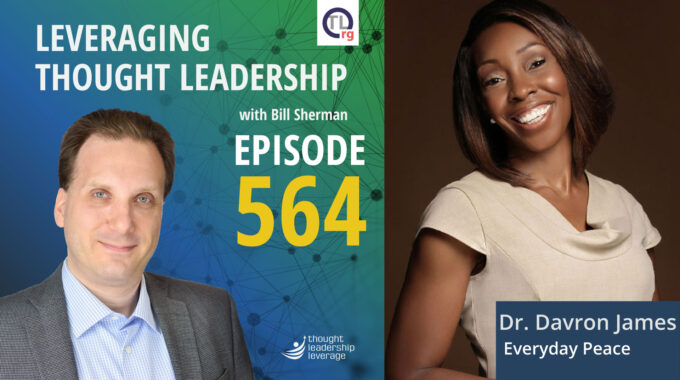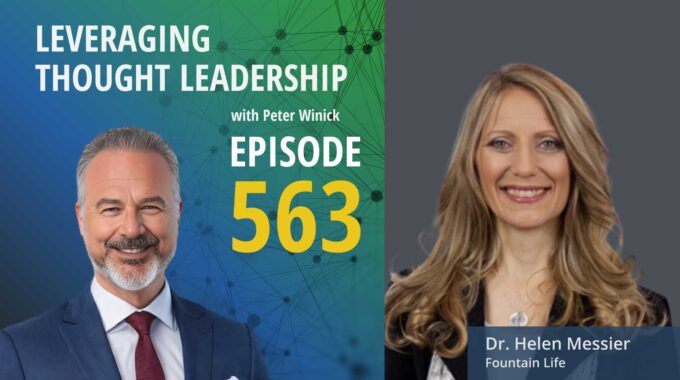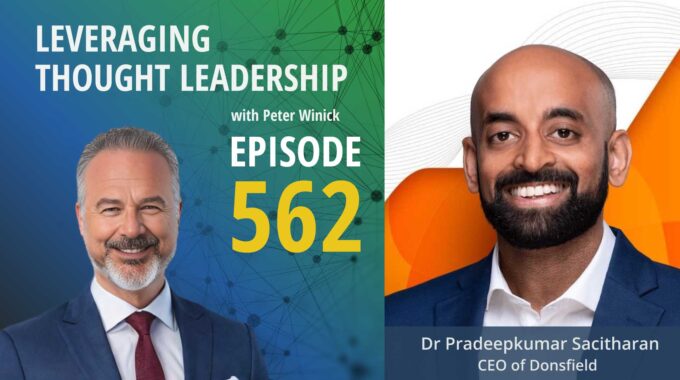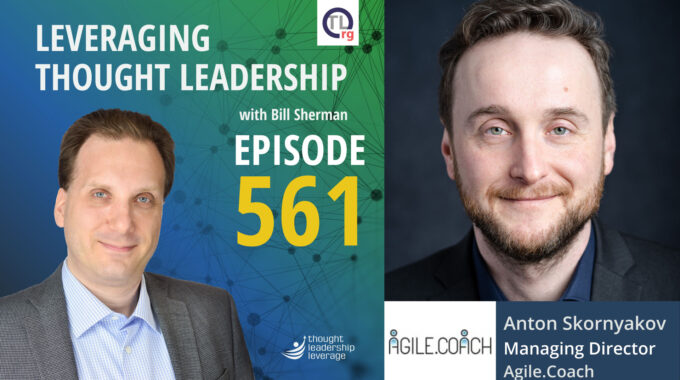Embracing Self-Awareness for Personal Growth and Peace A conversation with Dr. Davron James about her…
Developing Assessments from Thought Leadership | Tony Alessandra
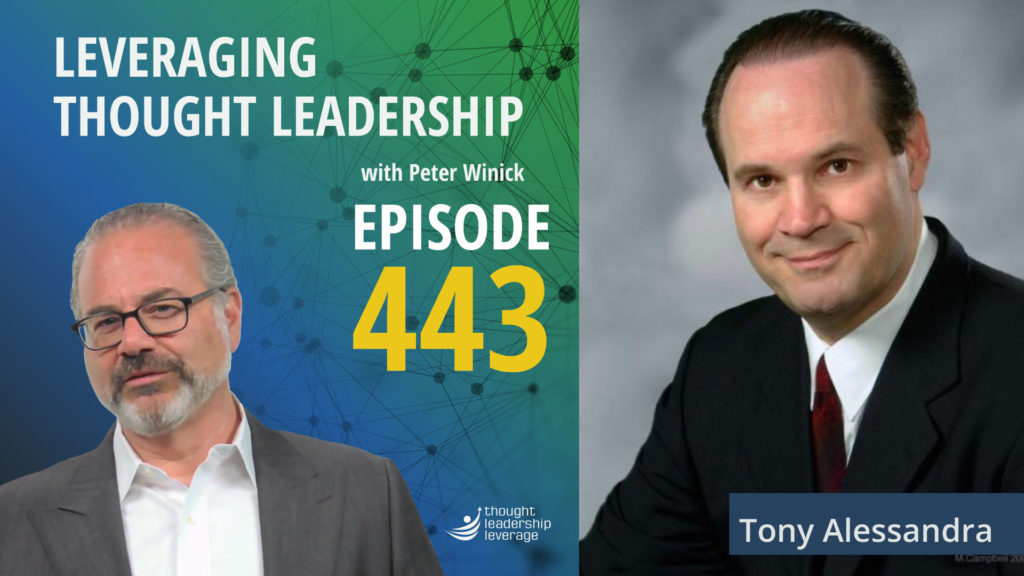
Creating, validating, and monetizing assessments.
An interview with Tony Alessandra that originally aired on March 23rd, 2021, as part of our Leveraging Thought Leadership Live series on LinkedIn.
Creating an organizational assessment isn’t as simple as you might think.
It’s more than a list of questions with multiple-choice answers, like you might find in a magazine\s “personality quiz.”
Reliable assessments take careful research, which must be validated in order to prove the results are accurate and actionable.
To discuss the intricacies of creating strong thought leadership assessments, I’ve invited Tony Alessandra to join me. Tony Alessandra is the Founder and CEO of Assessments 24×7, the global leader in assessment technology. He is also a prolific author of more than 30 books, including What Makes Humans Tick?: Exploring the Best Validated Assessments and The Ten Qualities of the World’s Greatest Communicators. Plus, he is a Hall of Fame speaker and the World’s Top Communication Guru.
We start our conversation by getting an understanding of the difference between an assessment and a validated assessment. Tony explains how a validated assessment meets the requirements of the American Psychological Association, getting a minimum score on a statistical measurement to ensure the results are reliable. That means clients will trust your results, and that means more business.
Often, thought leaders want to take their speaking (or book) and monetize it as an assessment, but to make that work, you need to do a lot of work, validation, and statistical design.Tony gives tips for must-haves, if you want your assessment to find financial success.
We’d be remiss to have a Hall of Fame speaker on without discussing the speaking industry! We close out the conversation by discussing the slow decline of speaking since the early 2000s, and the rise of virtual events. Tony shares the pros of speaking engagements using online technology, and the cons of not being in person.
If you are thinking about creating an assessment for your thought leadership, this episode is essential.
Three Key Takeaways:
- When creating an assessment, have it validated by a third party to avoid any possible bias in the results.
- If you’re thinking of creating an assessment, having a mobile app for it is crucial. The more steps involved in taking an assessment, the fewer people will finish it.
- Technology allows us to do speaking engagements remotely, adding slides, video, and interactive elements that can actually deliver more value than being in person.
If you need a strategy to bring your thought leadership to market, Thought Leadership Leverage can assist you! Contact us for more information. In addition, we can help you implement marketing, research, and sales. Let us help you so you can devote yourself to what you do best.
Transcript
Peter Winick And welcome, welcome, welcome. This is Peter Winick. I’m the founder and CEO at Thought Leadership Leverage. And you’re joining us on the LinkedIn Live, which is an extension of our podcast, which is Leveraging Thought Leadership. So, I want to introduce our guest today, Dr. Tony Alessandra, because he’s got a great bio and some cool stuff to share with us today. So, Tony, as a street wise, college smart perspective on business, having been raised in the housing projects of New York City and eventually realizing success as a graduate professor of marketing, Internet entrepreneur, business author and a Hall of Fame keynote speaker. He’s the founder and chairman of Assessments 24×7, which is a company that offers a variety of online assessments. He’s a prolific author. Prolific, I think is an understatement. When he’s got 41 books under his belt. He has been inducted into the Speaker’s Hall of Fame in the eighties, a legend in the speaking profession speaker icon, top five inaugural class of the Top Sales World Hall of Fame and number one World Pop Communication gurus. And that’s that is not all of the accolades, but let’s just dive in.
Peter Winick Tony, welcome aboard. Thank you so much for spending time with us this afternoon.
Tony Alessandra My pleasure, Peter. Thanks for having me on the show.
Peter Winick So you’ve been around the – this thought leader keynote business through many, many, many cycles. Right. The good. The bad. The ugly. Pre 911, post. Now, Covid. I want to start with assessments though and this is where we could geek out a little bit. So I love assessments and the reason I love them. There’s a couple of reasons. From a business model standpoint, they’re the best, right? So you can produce a tool once, use it again and again and again. But I want to get your take, because what we see a lot of is people that don’t know or don’t understand. And this is similar to the problem we have in instructional design. Think, Oh, I can just scribble out ten questions and do this and do that and whatever. But there are assessments and there are assessments, right, in terms of a validated instrument that always gives a consistent outcome. So give us sort of an overview of what a validated assessment is and we’ll get into the business side of it.
Tony Alessandra Yeah. So a validated assessment is one that meets the requirements of the American Psychological Association that they use from a statistical point of view. And I don’t want to get to them, but we want a score of a 0.7 or above from what we call the Crohn Bax Alpha, which is a statistical measure. And what we do internally and assessments 24 seven is we have an outside independent company do our validation. And the reason is when you do it internally and you look at the numbers and let’s say the number of says no at 2.68, you say to yourself and we just jack it up to a point seven, one or whatever. There’s just some monkey business that can happen if if you do your own internal validation. So we have a whole separate company and sometimes when they do the validation, it doesn’t come out and we have to go back, get hundreds of more data points for them with data point people.
Peter Winick But I want to I want to go to the point of the validation is basically you’re saying to the buyer, to the market, this is a true and reliable instrument, right? So if I were in the business of selling rulers and every time I sold the ruler, people got different measurements, I would be bankrupt pretty quickly. So all the validation is ultimately doing is giving proof positive to the buyer that if we’re measuring whatever a personality trait, an ability, a capability, whatever, that in a certain set of circumstances you give the same inputs, you get the same outcome. Right. And I think.
Tony Alessandra Exactly. And it’s sort of like validation is like the Good Housekeeping Seal of approval. And the proof of the pudding is when people take, for instance, our disk assessment almost 100%, people look at this and say this is me. I mean, it really creates an accurate description of being in the.
Peter Winick Right. It’s not fortune telling. So I think what happened is and I’d love your thoughts on this. Early on in someone’s journey as a thought leader. They’ve got maybe they’ve got a book, they’ve got a keynote, and they see other folks have an assessment. So, they say, I’m a smart guy or gal. I think I can create. Let me ask a couple of questions. Let me do this, you know, whatever. And if you’re selling to consumers, the reality is consumers just don’t know what they don’t know. So, they will not care, necessarily, if something’s validated or not. Where we tend to put our energy and efforts in and I think is where you are as well, Tony, is in the B2B side, on the enterprise side. So, what happens is you might get away with an invalid dated instrument for a period of time. It might even be viably commercially successful. And then you go into the B, the B side, and there will be someone on the client side, particularly the Fortune 1000. This is great. Show me your validation study. Show me this. And if the answer is no, it’s going to be a really short meeting and you talk to that.
Tony Alessandra Yeah. And we do have a lot of people who have a book coming out and basically say, you know, we’d like to create an assessment. And what we tell them to do is to go to an independent company. An example would be a company called Hambro H. Um. Ah. Oh. And what they do is create assessments and validate them. But it’s a very expensive process to do that. And that’s why a lot of individuals say, you know what, I’m just going to do a simple process, sort of like what you would see in a magazine know right there. You know, so.
Peter Winick Yeah. So, your focus is more on the distribution side of assessments as opposed to the validation side of 24×7?
Tony Alessandra Absolutely. Yeah. So, we don’t validate we have somebody else do that, but we do validate that’s crucial because most of our business is either through business coaches that are working business clients. And those clients want to know that the assessments really do work and are telling us the truth and also our end user or corporate clients, which could be anywhere from Starbucks to Microsoft to Tesla or whatever.
Peter Winick Yep. Yep. So any advice or recommendations on someone that’s maybe a little bit early in the journey that is thinking of developing or deploying or monetizing their thought leadership through an assessment? Any tips or recommendations you have for them, Tony?
Tony Alessandra Yeah. So what we typically find, Peter, is people either want an assessment so that they can generate leads. Right. Or interested. So it would be I want an assessment simply to have people take the assessment and maybe allow me to sell them something else, whether it be my book or a virtual training program, whatever.
Peter Winick So let me let me pause you there. So I think there’s I want to make sure I’m getting this right. There’s kind of a continuum. There’s the free assessments on not monetizing that assessment directly. But the benefit is I’m collecting emails. It’s giving people another level of depth into my IP. Maybe they’ve read the book or an article, but it’s another way for them to interact with me. Pre-buy/sell. Right. So these are certain assessments that are on the marketing side is what you’re saying and, yeah.
Tony Alessandra What people are going to do, that free version. They’re not going to put the money into validating this. So, it’s way too expensive.
Peter Winick Sure.
Tony Alessandra And would be people who really want to. To monetize their assessments. So, they’re charging money. They’re charging per person.
Peter Winick Sure.
Tony Alessandra Those are the people that will, in fact, put the money in and develop validated assessments.
Peter Winick Got it. And are the best practices that you’ve seen there in terms of interface. And because one of the things that I’m starting to see now, there are assessments that have been out in the market for a long, long time that not not from a validation standpoint, but visually, maybe they’re a little bit dated or they’re not available mobile on an app and maybe touch on that a little bit.
Tony Alessandra Yeah. Well, I can tell you right now that being mobile on an app is crucial because one more of the people in business now are younger people, whether it be millennials or Gen X, Gen Y, and they do a lot of stuff on their mobile devices. So we’re totally mobile. You also want it totally automated. The more steps that you’re asking people to take to do an assessment, the less likely they will get to the end and finish it. So when we talk to people about building an assessment, we first ask them, how complex is the assessment that you are building? Some people simply want the questions with what’s called a Likert scale. Strongly agree, not always or never. That’s a leopard scale, typically a five point scale or some sort of mathematical algorithm that you use to compute things. A good example of a mathematical algorithm would be the desk assessment. We use a very.
Peter Winick Sort of weighted averages against each piece to get that.
Tony Alessandra Exactly. We also ask people, okay, if you’re doing this assessment, is it a self assessment only or do you want what’s called a 360 or greater based? 360 would be I take the assessment to determine how I see myself and my behaviors, and then I send it out to a representative group of other people, which could be if I’m in the company, it could be my my direct manager, my peers and my direct reports. That’s a 360 where they tell me how they see my performance. And then I.
Peter Winick Stay there for a minute because the data tells us that most of us are pretty lousy at celebrating. Right. So this is the Lake Wobegon. In fact, I’m a better than average driver. I’m better looking. I’m smarter than like. Mathematically, not everybody could be better than average. Right. But when you ask, how am I? So there is also I forgot what the word is for this, but you probably know there’s a way to get people to sort of self rate but finagel the language a little bit to say people around here. Dot, dot, dot. Right. So you can play with that a little bit. But I love the 360 piece because then if you’re a coach or consultant, you say, Well, hey, Peter, you think you’re agreeable, easy to get along with, but everybody else around here sees things a bit much differently. Let’s talk about that. Right. And that becomes the basis of a good coaching call or a good consulting call.
Tony Alessandra Exactly. So we have seen leaders do this and you get what the direct reports may say. And it tells you how I can develop coaching or training built around improving their performance. From a sales person’s perspective, what we’d love to do is to have the sales manager, their fellow salespeople and customers, their customer giving feedback. Hey, I think I’m really good at, quote, closing the sale, but my customers are saying, no, you know, that’s terrible or whatever. Basically tells us what we should do to improve and develop. And usually with three, six days, if you are using it as part of a a development program for the employees, you want to have people retake it, whether it be three months or six months or maximum a year down the road to see if, in fact, they have improved by sending the assessments to the same people, like different people, same people.
Peter Winick If you’re enjoying this episode of Leveraging Thought Leadership, please make sure to subscribe. If you’d like to help spread the word about our podcast, please leave us a review and share it with your friends. We’re available on Apple Podcasts and on all major listening apps as well as at ThoughtLeadershipLeverage.com/podcasts.
Peter Winick So, so let’s stay there for a bit. And herein lies the beauty of part of the business model, right? So, you take a test, you take an assessment, and it shows you things that you do great things that you need to work on, things that maybe not so great, whatever. Then you commit to some sort of an intervention, right? I’m going to do X, Y and Z over the next six months and then I’m going to check it again. Right. And the reality is, if I use the analogy of a die, if I was on a diet for six months and got on the scale pre and post and the needle didn’t move, it’s clear that that was a failure. We can get into the whys, but it just didn’t work. So, one is when we’re going back and re measuring six months later click the cash register rings again. Right. That’s the beauty of it. And we get to we get to turn subjectivity into objectivity. Hey, look, this didn’t move. It says you are still a seven and the goal was to get you to a nine. Right. I love the business model there. Are you seeing anything in terms of exits and acquisitions that thought leaders are having of their assessment tool side of their business? Right. Nobody’s buying anybody’s speaking business. That’s not news to anybody. But an assessment does potentially position that part of the business to have an exit any thoughts or things to share there?
Tony Alessandra Well, I can tell you. For the last 30 plus years, I have been a motivational speaker, and in the last two years that business has really, really dried up. But the assessment business you our revenue last year 2021 went up just slightly more than 55 0%. So because of the virtual nature of assessments, because of the accuracy, it allows us to reach people not necessarily in live environments. And just like we’re doing right now, where we can actually see each other and talk to each other, you and me, we can actually have let’s say I’m a manager, you’re one of my employees. You’ve taken a 30, 60 or a desk assessment. We could actually do our coaching and personal development right here. Not necessarily –
Peter Winick Right.
Tony Alessandra Face to face, you know, live, but here we are.
Peter Winick Well, I think the other thing is, if we look at a company making an investment into you or anybody else as a speaker, that’s a big-ticket item. If they took those same dollars and put it into an assessment investment, they’re going to touch a lot more people at a different level. At a better level. It’s a different it’s a different touchpoint. Right? You can reach dozens, hundreds or whatever depending on your speaking. So let’s go back to the speaking side, because you’ve been, you know, sort of as I opened with, you’ve been around this speaking thing for quite some time, the good, the bad, the ugly. Give us a sense of what you’re seeing now. Obviously, everything’s going digital, going remote. I mean, I guess my my big question is, do you think it ever gets back to 2019 and pre levels in terms of in-person event living on airplanes, doing 80 gigs a year or what? What are your thoughts and experiences?
Tony Alessandra Yeah, no, no, we have we’ve definitely had structural differences. And by the way, this all started probably right around 2000, 2001 when, you know, the stock market, especially technology in the 911. So before 2000, like in 1999, I remember this vividly, 1999 I had 99 cases just that.
Peter Winick And you weren’t trying to get to 100 and it still bothers you, were you?
Tony Alessandra It allows me to remember 1999 and typically a full calendar was about 100 speeches a year prior to 2000 after 911. My personal thought was that the full calendar dropped to about 80 after 2008, the Great Recession, a full calendar drop to maybe 50 or 60, now after the Corona virus, COVID, etc., etc., you know, you’re not maybe looking at a full calendar at 25 and that’s in-person at 25 or 40 years ago, maybe, maybe 25. And the reason is because of the technology over the years that has gotten so good. And some speakers now are doing three and four speeches a day. On Zoom or platforms like this and still charging enough money that they’re making more money than they would have made on a single live speech. So the technology, the equipment that you can use that can change screens and pull up video segments. Some speakers have gotten so good at this that actually the virtual presentation is better than a slide presentation in terms of what they bring in.
Peter Winick They can show value. And I mean I mean the technology, the piece, and then the cost is another. It doesn’t take much to produce like amazing high-quality stuff from your desk at home without spending tens or hundreds of thousands of dollars. I mean, you could you could trick out whatever you need for a really reasonable price now. So I think that’s interesting. I also see I would love to get your take on this, that this is a great way to deliver content. Right. We’re having a conversation. I can see your body language. We can talk. It’s better than audio, whatever. It’s kind of a lousy way when I say this is not just this platform, any of them. Not a great way to create community and not a great way for connection. Right. So those are the pieces that are still, I think, human needs that that in-person event satisfies in a way that the technology either can’t or can’t as of yet. Right. Because why do we go to all these events? Right. We go part of it is the program. But the other part is just, you know, random. You know, it’s interesting when you talk to event planners about the best events they did, they’ll repeat the theme and the look and the feel and the venue. Ask participants about the great event they went. They’ll say, oh 26. At the time I met Alessandra and we were, you know, we’re at the bar together and we became really good friends or, you know, that was the other time where, you know, such and such happened. So I think there’s a difference between the producers and the participants.
Tony Alessandra Yeah. Yeah. I have always found that the interaction, the networking during breaks and meals has as much, if not more impact on the attendee at a live conference than actually the speakers.
Peter Winick Right. Said the speaker. Right.
Tony Alessandra Yeah, that’s right. I mean, you got to be honest with it.
Peter Winick Yeah. No, listen, there’s nothing. There’s nothing like a great speaker in their element doing what they do best. So any other as we start to get ready to wrap up here, Tony, any other thoughts or reflections for folks on either the speaking side, the assessment side, life in general?
Tony Alessandra Well, you know, I just have certain philosophies as, you know, we’ve come through a couple of really tough years, and I don’t think we’re still over it yet. I’m flying to London on Monday, but to get back into the United States, I’ve got to take a COVID test within 24 hours, even though I’m totally vaccinated. But, you know, so it’s still there. I just live by certain philosophies that I keep telling myself, no matter how good or how bad, especially how bad, this too shall pass. And it will. It will. What goes around comes around. You know, I always. I’m always out there helping people, not expecting anything in return. But believe it or not, I always get something in return. Maybe not from them, but some. Somehow. Somewhere. And. You know, I just I tend to be generous with my time and my money. You know, I went to college, I went to the University of Notre Dame on a scholarship for need, not academic. And now that I have been successful, I’ve actually endowed a scholarship at Notre Dame for so well-constructed but can’t afford to go there, because that’s what happened to me. So, you know, again, what goes around comes around.
Peter Winick Yeah.
Tony Alessandra Waiting for a diagnosis is malpractice. These are rules that I live by that they’re evergreen. They’re evergreen, which they were. They were valid 20 or 30 years ago. They’ll be valid 20 or 30 years from now.
Peter Winick Well, this has been great. I appreciate you spending time with us and sharing your experiences, your thoughts, your expertise, an example of the principles that you just talked about, of the generosity and such. I appreciate you and appreciate your time, Tony. Thank you so much.
Tony Alessandra Thank you very much, Peter. My pleasure.
Peter Winick To learn more about Thought Leadership Leverage, please visit our website at ThoughtLeadershipLeverage.com to reach me directly. Feel free to email me at Peter at ThoughtLeadershipLeverage.com and please subscribe to Leveraging Thought Leadership on iTunes or your favorite podcast app to get your weekly episode automatically.



